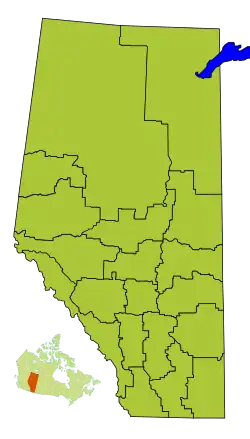Division No. 17 | |
|---|---|
| Country | Canada |
| Province | Alberta |
| Area | |
| • Total | 192,116 km2 (74,176 sq mi) |
| Population (2011)[1] | |
| • Total | 61,504 |
| • Density | 0.32/km2 (0.83/sq mi) |
Division No. 17 is a census division in Alberta, Canada. It spans the central and northwest portions of northern Alberta and its largest urban community is the Town of Slave Lake. Division No. 17 is the largest census division in Alberta according to area and also has the lowest population density.[2]
Census subdivisions
The following census subdivisions (municipalities or municipal equivalents) are located within Alberta's Division No. 17.[3][4]
- Towns
- Villages
- Hamlets
- Specialized municipalities
- Municipal districts
- Indian reserves
- Beaver Ranch 163 which is part of the Tallcree First Nation.
- Boyer 164
- Bushe River 207 which is part of Dene Tha' First Nation.
- Child Lake 164A which is part of the Beaver First Nation.
- Clear Hills 152C which is part of the Horse Lake First Nation.
- Drift Pile River 150 which is part of Driftpile First Nation also known as Driftpile Cree Nation
- Fort Vermilion 173B which is part of Tallcree First Nation.
- Fox Lake 162 which is part of the Little Red River Cree Nation.
- Hay Lake 209 which is part of the Dene Tha' First Nation.
- Jean Baptiste Gambler 183 which is part of the Bigstone Cree Nation.
- John d'Or Prairie 215 which is part of the Little Red River Cree Nation.[5]
- Kapawe'no First Nation
- Kapawe'no 150B, historically known as Freeman 150B, which is part of the Kapawe'no First Nation.[6]
- Kapawe'no 230, also known as, which is part of the Kapawe'no First Nation.[7]
- Kapawe'no 150C also known as Halcro 150C, which is part of the which is part of the Kapawe'no First Nation.[8]
- Pakashan 150D
- Loon Lake 235
- Sawridge 150G
- Sawridge 150H
- Sucker Creek 150A
- Swan River 150E
- Tall Cree 173
- Tall Cree 173A
- Upper Hay River 212
- Utikoomak Lake 155
- Utikoomak Lake 155A
- Wabasca 166
- Wabasca 166A
- Wabasca 166B
- Wabasca 166C
- Wabasca 166D
- Woodland Cree 226
- Woodland Cree 228
- Indian settlements
Demographics
In the 2021 Census of Population conducted by Statistics Canada, Division No. 17 had a population of 62,132 living in 20,539 of its 24,540 total private dwellings, a change of 0.9% from its 2016 population of 61,590. With a land area of 190,433.83 km2 (73,526.91 sq mi), it had a population density of 0.3/km2 (0.8/sq mi) in 2021.[9]
See also
References
- 1 2 "Population and dwelling counts, for Canada, provinces and territories, and census divisions, 2011 and 2006 censuses (Alberta)". Statistics Canada. February 8, 2012. Retrieved February 16, 2012.
- ↑ "Population and dwelling counts, for Canada, provinces and territories, and census divisions, 2006 and 2001 censuses - 100% data (Alberta)". Statistics Canada. January 6, 2010. Retrieved August 30, 2011.
- ↑ "2006 Community Profiles, Geographic hierarchy – Division No. 17 (Census division)". Statistics Canada. December 7, 2010. Retrieved August 30, 2011.
- ↑ "2022 Municipal Codes" (PDF). Alberta Municipal Affairs. January 5, 2022. Retrieved January 21, 2022.
- ↑ "JOHN d'OR PRAIRIE 215 - Aboriginal Communities". Archived from the original on July 17, 2012. Retrieved August 22, 2012.
- ↑ Government of Alberta (May 25, 2019). Municipal Boundaries (Map). AltaLIS.
- ↑ "Reserve/Settlement/Village Detail". Crown–Indigenous Relations and Northern Affairs Canada. Government of Canada. Retrieved August 12, 2019.
- ↑ "Reserve/Settlement/Village Detail". Crown–Indigenous Relations and Northern Affairs Canada. Government of Canada. Retrieved August 12, 2019.
- ↑ "Population and dwelling counts: Canada and census divisions". Statistics Canada. February 9, 2022. Retrieved April 2, 2022.
